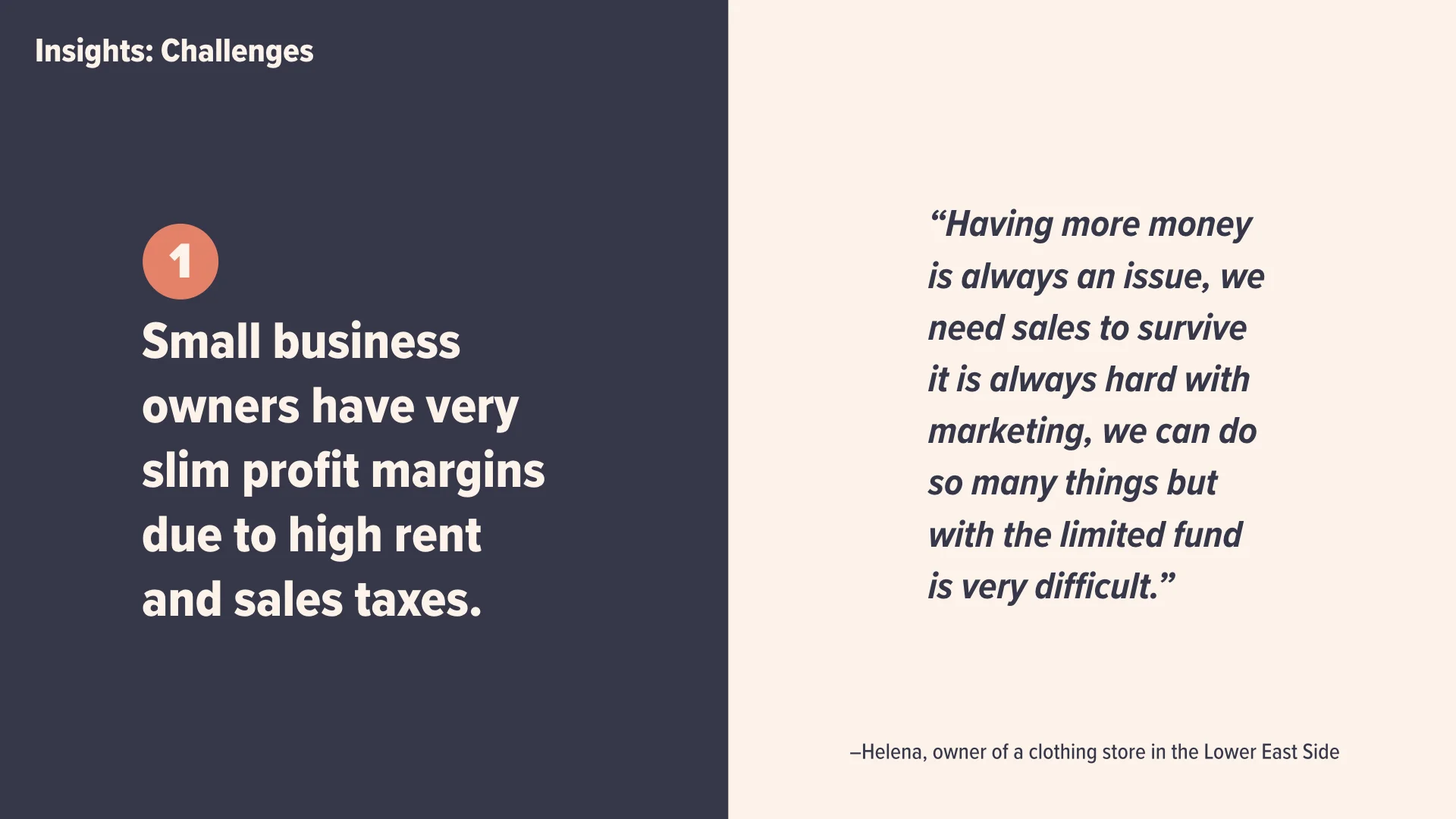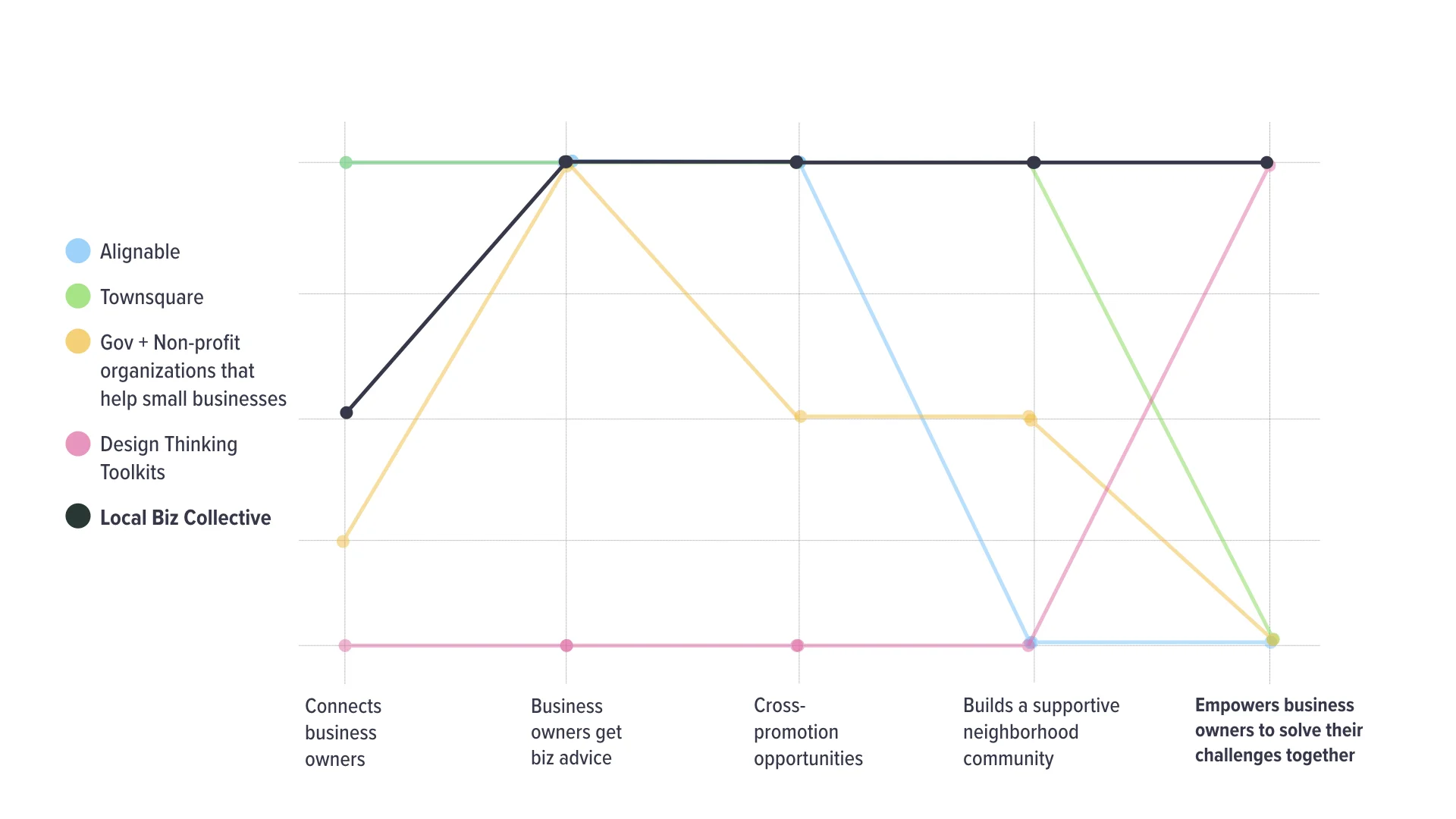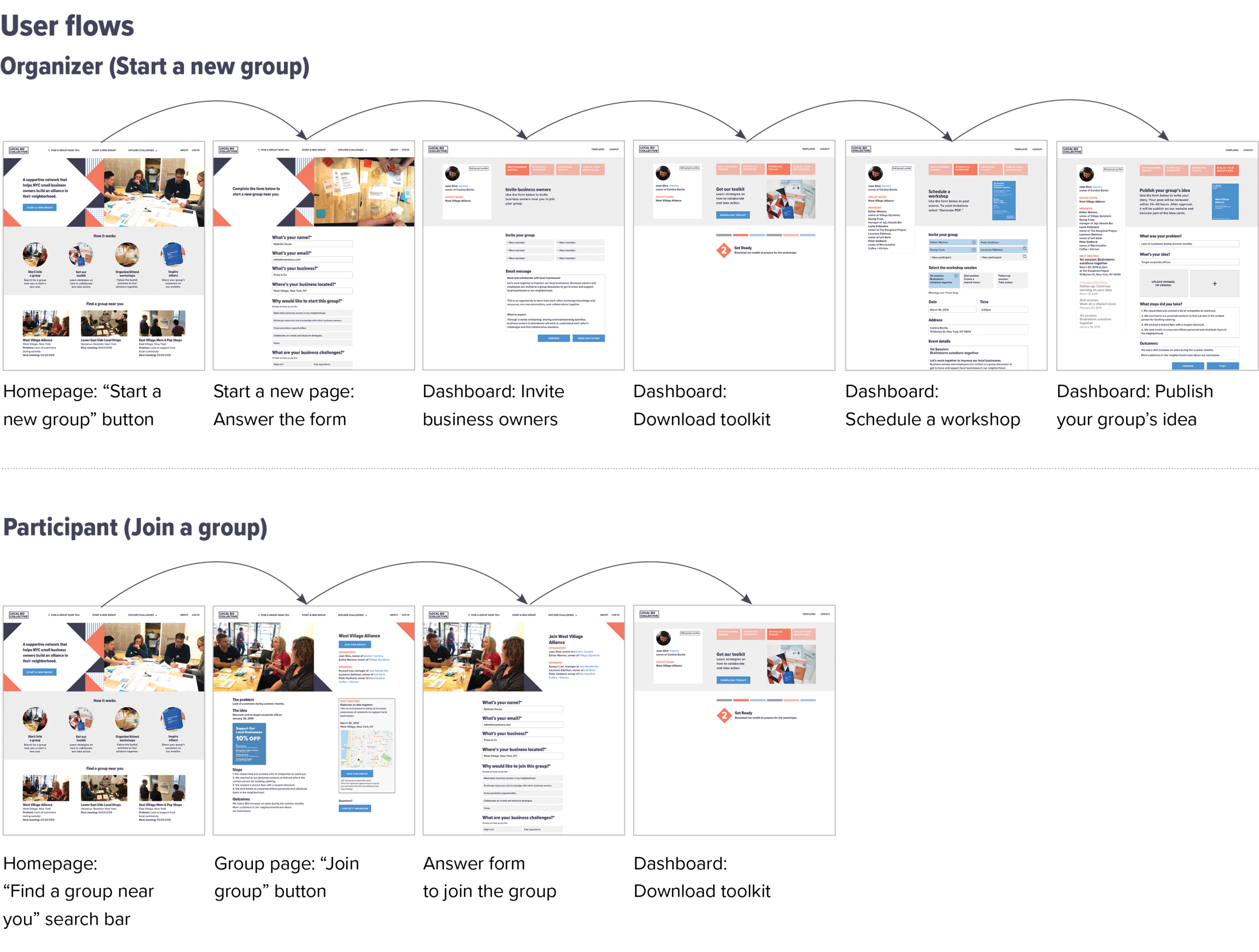Video of thesis presentation
Local Biz Collective
interaction & service Design
Thesis Project of the MFA Interaction Design program at the School of Visual Arts
How might we empower small business owners to connect and work together to help one another?
Challenge
Gentrification and soaring rent increases have made it nearly impossible for New York City small businesses to stay open. The ones that are still open are barely making ends meet. They don’t have enough time or revenue to spend on new marketing strategies. To conserve costs, business owners have to wear many hats to run their establishments, which can be very lonely sometimes. They don’t have a team with which they can share their challenges or from whom they can get feedback.
Date
September 2018–May 2019
Role
Interaction & Service Designer, Researcher
Thesis Advisor
Katherine Fisher, Strategist, Research, Program Manager at 3x3 Design
Solution
Local Biz Collective is a supportive network that helps New York City small business owners build an alliance in their neighborhood. The service has two main offerings: a toolkit and a website.
The toolkit offers a framework of three workshops with engaging activities that help business owners solve their biggest challenges together. The workshops help business owners collaborate and implement ideas together.
The website empowers business owners to connect with others near them, schedule workshops, invite others to join their group, and download the toolkit. With these tools, business owners can work together to co-address the obstacles of their industry.
Target audience
NYC small business owners of an independently owned business (not a franchise) that have:
0–20 employees
A storefront space
Non-profit advocates and public servants, who provide services to local businesses.
Design Process
Discovery Phase
Desk Research
Last September, as I was walking by Christopher Street in Manhattan, I noticed that the block between Hudson and Bleecker streets had eight vacant stores. To understand why businesses were closing, I did secondary research on the history and current state of gentrification and local policies. This initial research helped me narrow down the areas of focus of the final solution.
Key insight:
In New York City, the main reason businesses are closing is the high rental increases and low-profit margins. Unfortunately, there aren’t enough public policies in place that prioritize the interests of small business owners over those of real estate developers. Since small business owners can’t rely on politicians or policymakers to support them, I decided to create a solution that would empower them to solve their own issues, so they could improve their businesses and increase their profit margins to have better chances to thrive.
A local business is closed on Christopher Street, NYC. Photo taken on September 2018.
User Research: Business Owners
I conducted both qualitative and quantitative user research, through interviews with ten local small business owners, and a survey with responses from eighteen business owners. This research helped understand the key challenges small business owners face and identify opportunities to help them.
Key insight:
Due to high rent and low-profit margins, to conserve costs, small business owners have to wear many hats to run their establishments. They do not have enough time and revenue to spend on improving their businesses. In addition, running a business on their own can be very lonely. In contrast, businesses owners that have a community fueled by other business owners feel more supported and have credited their successes to these relationships. This insight led me to develop a service that connects business owners to learn from one another and facilitates them on how to implement ideas together to solve their shared challenges.
(Names have been changed to protect the privacy of individuals).
User Research: Experts
I conducted interviews with two public servants from NYC Small Business Services (SBS) and two non-profit advocates from the East Village Community Coalition (EVCC) and the Cooper Square Committee, to learn from existing resources and policies for small business owners and discover what challenges these organizations face when interacting with small businesses. I also wanted to validate my prototype and insights gathered during user research.
Key insight:
These organizations offer many free services, but they struggle with reaching the business owners who would benefit most. The main reasons are the stigma of trusting government agencies and advocates, and lack of time or availability attending classes and events due to business owners’ limited schedule. Experts at SBS and non-profits saw a need for the Local Biz Collective toolkit, and even something they could apply to their work to better assist and understand the needs of business owners.
Competitive Review
I conducted an analysis of existing services for small businesses and IDEO’s Human-Centered Design toolkit. The purpose of this research was to learn from competitors and discover existing gaps in their services to create a solution that is not only innovative but also a complement to these services.
Key insights:
What makes Local Biz Collective innovative is that it is designed to not only connect business owners in their neighborhood but also give a framework and tools for them to use when they meet so that their meetings are relevant and productive.
Different from other design thinking toolkits, Local Biz Collective toolkit is designed without the use of design jargon, so non-designers can understand how to facilitate and participate in the workshops. Moreover, it is designed taking into consideration the time constraints and the specific challenges that NYC small business owners face.
Lastly, Local Biz Collective gives business owners ownership to solve their challenges at their own pace, and the toolkit acts as a facilitator without the need of a third party. The meetings are structured to last only one hour, and they can happen based on the participants’ availability and preferences.
Services that were reviewed:
Networking/skill sharing services:
Non-profits:
Ideation Phase
Brainstorming of 5Es journey for framework of the workshop in November 2018.
Prototype: Toolkit
The prototype of the toolkit tools and workshops were tested and iterated seven times with a total of twelve business owners in the Lower East Side and the West Village during the period of seven months. This part of the process helped validate the concept, test the usability of the tools, understand what barriers would prevent business owners from using these tools, and measure the outcomes and impact.
Key insights:
Participants enjoyed meeting and perceived the value of the toolkit.
Creating a framework and tools, like the challenge and idea cards, helped spark the conversations, and keep the meeting on topic and productive.
The first meeting was a success because participants wanted to meet again. For the second prototype, I created a new activity, “Elaborate an idea” to inspire them to take action.
Time constraints were a huge challenge. The design decision of developing a framework of three workshops of one-hour long each came from struggle of finding participants willing to commit for more than one hour.
Participants needed something to hold each other accountable to implement their ideas. For this reason, a new activity was created for them to brainstorm next steps and to assign tasks to each other.
To help business owners to continue working on their idea, I created the third framework, the Follow-up Session, so participants can review their tasks, seek help from each other, and continue brainstorming next steps.
User testing: Website & Toolkit
User testing of the high fidelity prototypes of the toolkit and the website was performed with four small business owners and three designers. The user testing helped to test the usability of the service offerings and to develop better integration of the toolkit and website.
Key insight:
Users did not perceive the value of the toolkit when reading the language of the website. They wanted to know how it works through easy steps and what problems they would be able to solve. These issues were addressed in the final voice and tone, features and design of the website.
Implementation Phase
User Story
I created three personas to capture the target audience and understand the different ways users would interact with the service: the organizer, the participant, and the advocate. I also developed a service blueprint to comprehend the functionality of the service's touchpoints, and the relationship between the toolkit and the website. And lastly, I created a user scenario of the primary persona, the organizer, to explain the solution to a broader audience. The user story compiles the real challenges and needs of participants who participated in the prototype phase.
Image of final design of toolkit cover (middle), worksheets (background), idea cards (left) and challenge cards (right).
Toolkit Final Design & Features
The toolkit offers strategies and tools to help users to connect, organize and participate in workshops. The workshop activities guide business owners on how to work collaboratively and inspire them to solve their shared businesses’ challenges.
Layout:
To make the tools more accessible, the final version of the toolkit evolved from being on 11x17 in size worksheets and big wall posters to a letter size pdf available for download on the website so that anyone can print them. The size was selected taking into account the fact that business owners will host workshops at their small shops with limited space.
Strategies
Start a new group:
Users get tips on how they can get started.
Get ready:
Users get advice on how to prepare before, during and after meetings.
Workshops
The toolkit offers three meetings framework. Each working session lasts one hour for a group discussion of six participants.
First session: Brainstorm solutions together
The purpose of the first session is for participants to get to know each other, build empathy and brainstorm ideas together.
Second session: Create a shared vision
The purpose of the second meeting is for participants to elaborate on an idea they had during the first session and brainstorm next steps.
Follow-up sessions: Take action
The purpose of the follow-up meetings is for participants to continue working on their idea, and hold themselves accountable by assigning tasks to each other.
Tools
Worksheets:
Prompts are designed to help guide discussions, and for participants to work collaboratively toward their shared goal.
Extra pages with white space are designed for participants to write or place post-its on it.
Time:
There are time reminders for each activity throughout the worksheets, that help participants to stay on track.
Agenda:
It reminds participants to introduce themselves with prompts that help them connect with one another.
It helps participants to be aware of what to expect.
It guides them to assign roles for the meeting, such as facilitator and note taker.
Book the next meeting:
It reminds participants to schedule the next meeting.
Tasks’ List Google Sheet template:
This template helps participants to capture their tasks and stay on track. It is available at Local Biz Collective website.
Challenge cards:
They guide the conversation to help participants, who may be stuck, and to keep the discussion on the topic. These are challenges from other business owners of the Local Biz Collective’s network.
Idea cards:
They inspire participants to take action. These ideas have been implemented by other groups in our network, and participants can check the website to learn more.
Website: Final Design & Features
The website helps business owners connect with one another. It offers resources that can help them find solutions to their challenges and get inspired by Local Biz Collective network’s ideas.
Homepage:
Users can find or start a new group in their neighborhood.
Users can also explore challenges to get inspired by the solutions other groups have created.
Users learn how it works, and get enticed to join by seeing what other groups are doing.
Start a new group page:
It gives users the confidence to start a new group by contacting organizers or seeing examples from other groups.
Group page:
Group’s organizers, members, previous and upcoming events, and published ideas are listed here.
To join a group and attend a meeting, users need to fill out a form to prove they have a small business at the neighborhood of the event. Only after vetted by the group’s organizer, they will receive the address of the next event.
Start a new group/Join a group forms:
Users get vetted by answering information about their business and their goals in joining the network.
Dashboard
Invite business owners:
Users can invite people to join their group via email.
Schedule a workshop:
Users can schedule a meeting, invite others via email and publish on their group page.
They can also generate a PDF of the invitation to invite people in person.
The language of the invitation is already set, but users can also edit the message.
They can select the session they are planning to host and their group members.
Download toolkit
Users can download the toolkit for free after completing the form and creating an account.
Group’s profile:
The organizer can edit the group’s name, add and remove participants.
The sidebar on the left of the dashboard lists the group’s activities, previous and upcoming events, and published ideas.
Publish your group’s idea:
The organizer can publish her/his group’s idea by answering the questions on the form and adding images or videos.
Their idea takes 24–48 hours to be approved by a Local Biz Collective volunteer.
They would then receive an email to be notified if it has been published or if their idea needs to be revised.
They can share the published idea on their social media or via email.
Their idea becomes part of the idea cards set. The toolkit is updated on a quarterly basis.
User flows
The website has two main user flows:
For the Organizer persona: Start a new group
For the Participant: Join a group.
site map
The site map is divided by the pages that are accessible to the general public and the dashboard pages, in which users have to create an account to access.
West Village local business owners during a workshop of Local Biz Collective in January 2019.
Impact
Local Biz Collective has been piloted in two NYC neighborhoods:
Two times with a group of three business owners in the Lower East Side, and one advocate from the Cooper Square Committee.
Five times with eight business owners in the West Village.
Local Impact:
Public servants and advocates have expressed interest in using the toolkit to continue their work of providing services to small businesses. In January, I collaborated with an advocate at the Copper Square Committee, facilitating a workshop for merchants in the Lower East Side.
Vision:
This service was initially targeted to serve New York City's small businesses, but it could be relevant and useful to businesses in major cities across the United States.
West Village Group:
This group continues to meet and use the tools to create a shared marketing strategy and a local businesses alliance.
Participants have created a supportive community: they help each other by exchanging knowledge and recommending each other business.
Two business owners who met in the pilot did a collaboration on February that brought more profit and extra exposure to their businesses. Jeju Noodle Bar and The Doughnut Project created a unique flavor doughnut that was sold on their shops, and they cross-promoted each other on their social media channels.
Conclusion
Local Biz Collective was created to empower small business owners to learn from each other, improve their business together, and build strong neighborhood communities. The West Village group is an example of how business owners can benefit from working together. I hope this initiative inspires business owners to continue using this framework to build more supportive communities in New York City, cities across the country, and even internationally. Moreover, I can see this project being scaled to help public servants and advocates to address other problems that could help save small businesses.























































